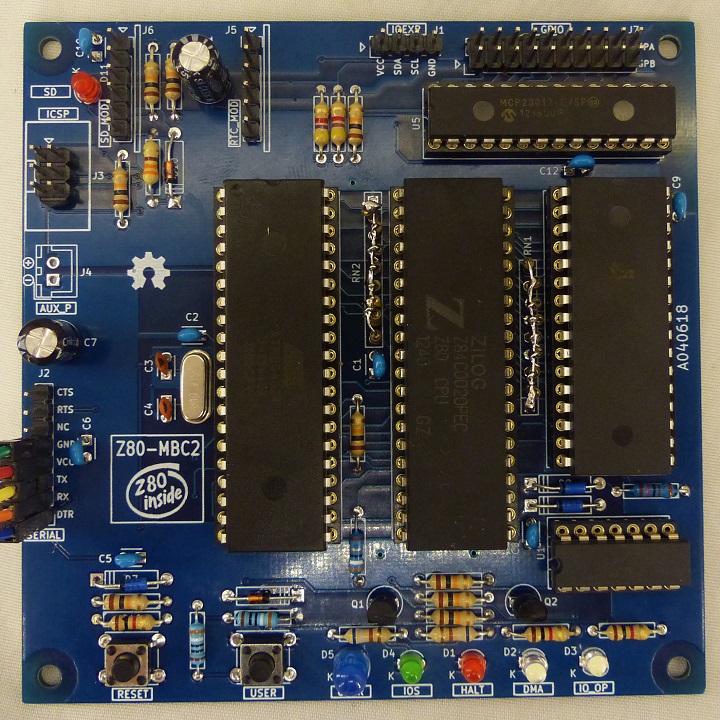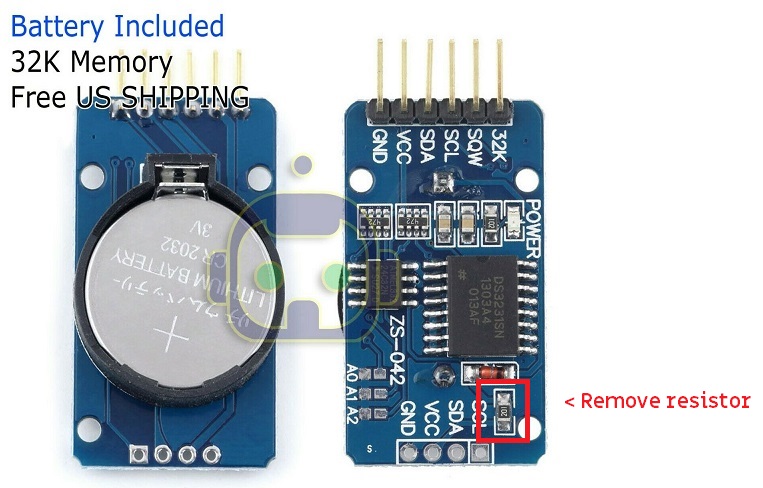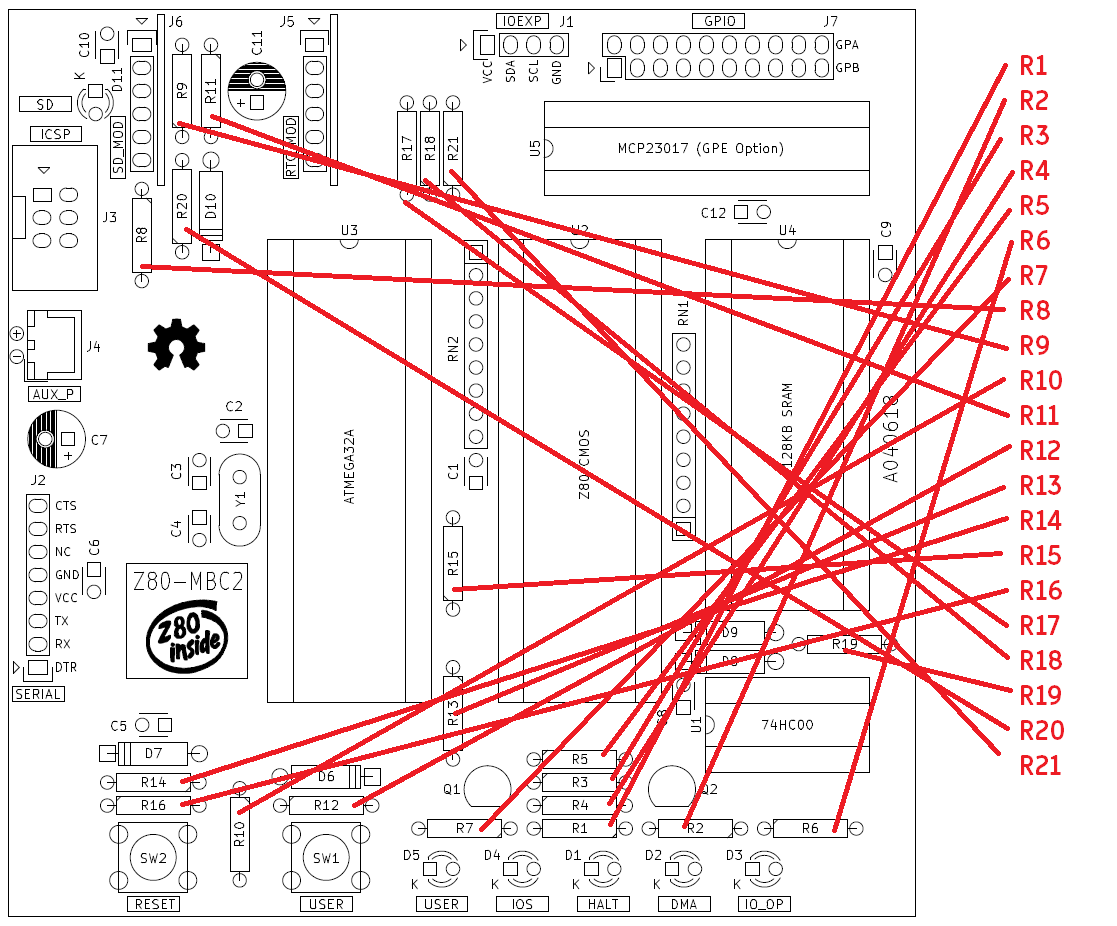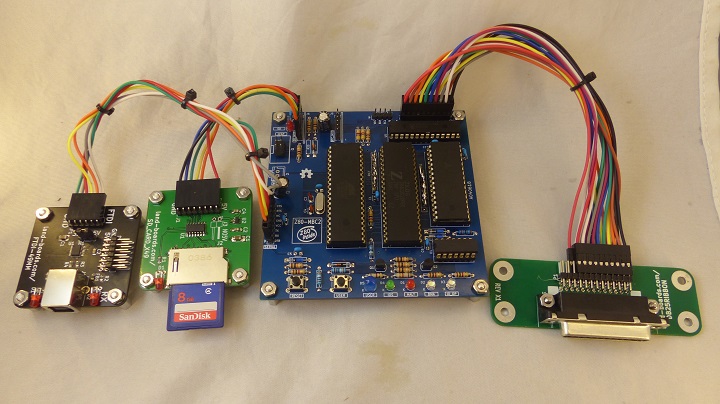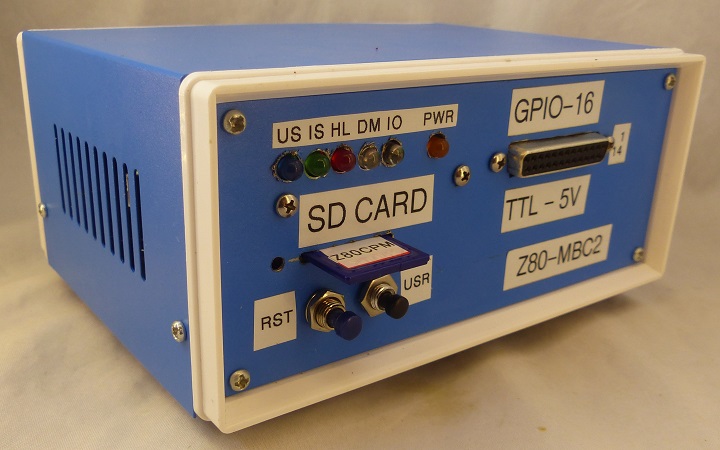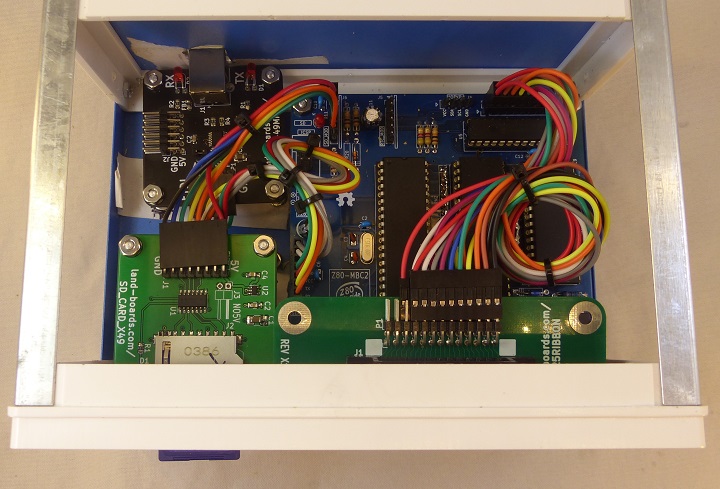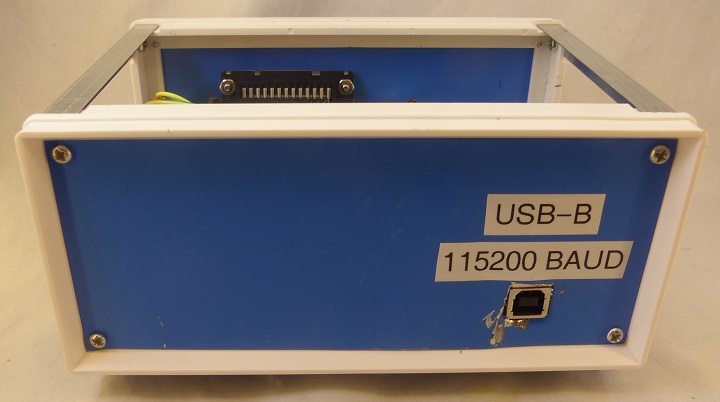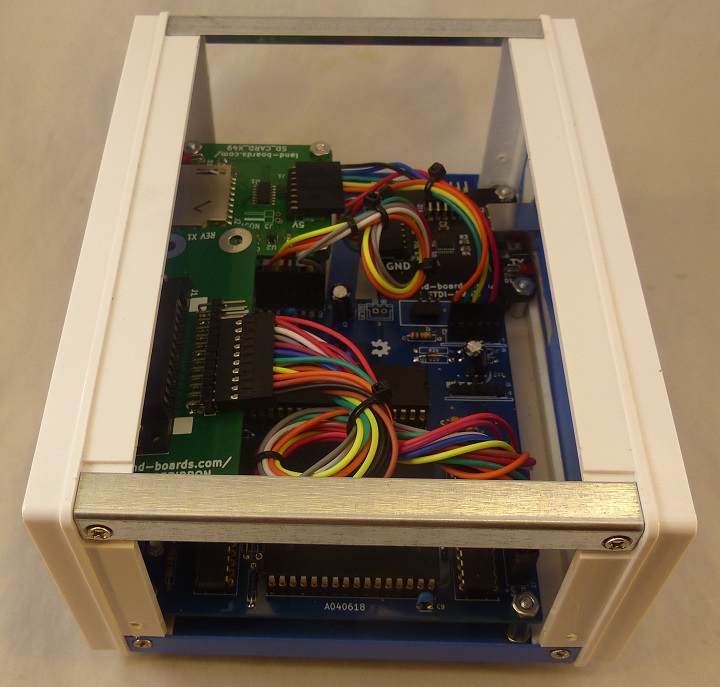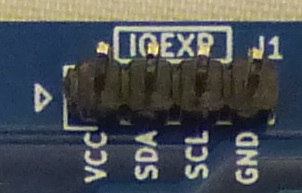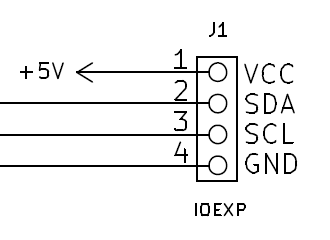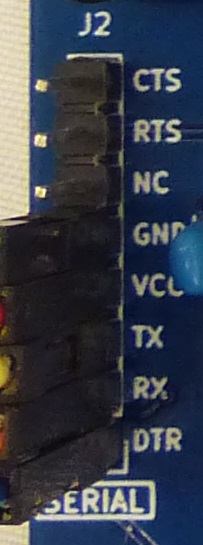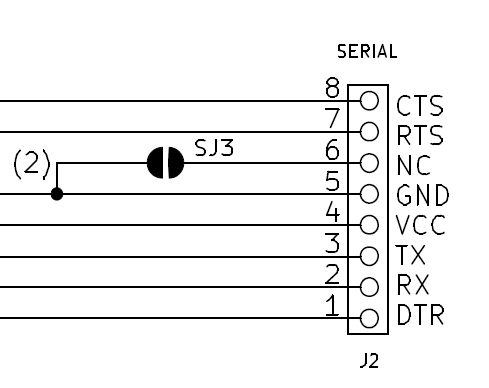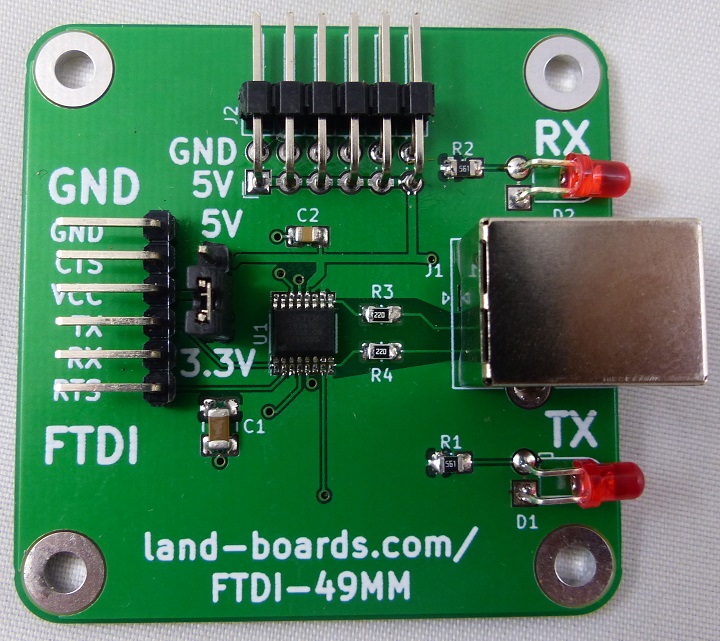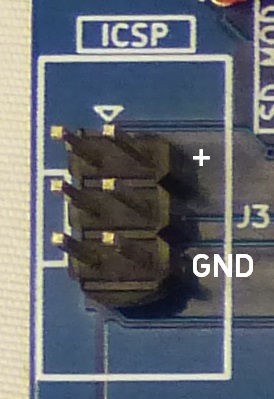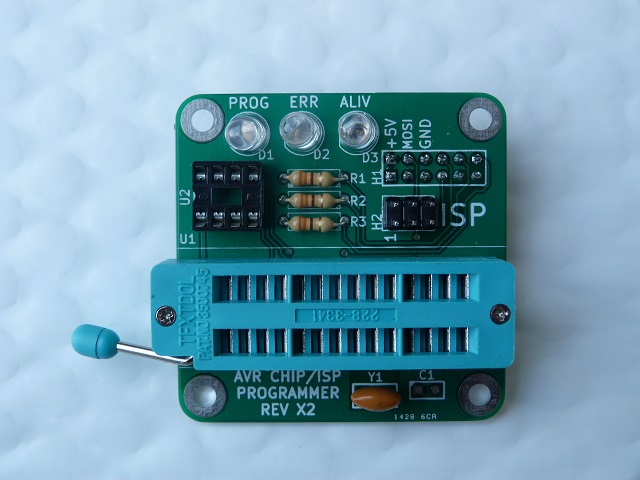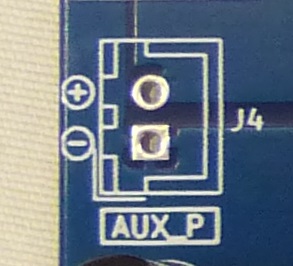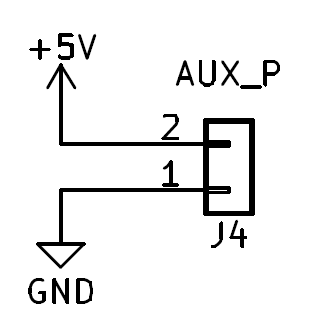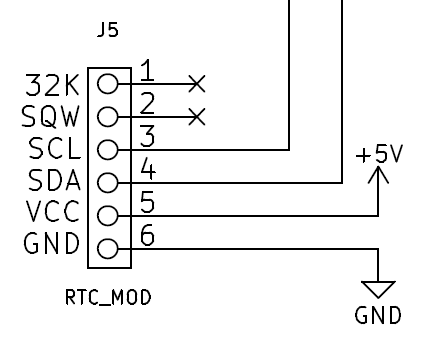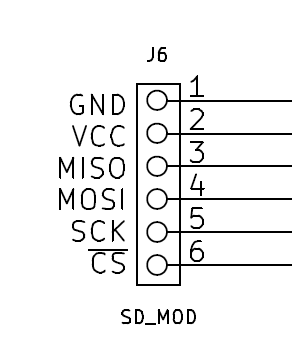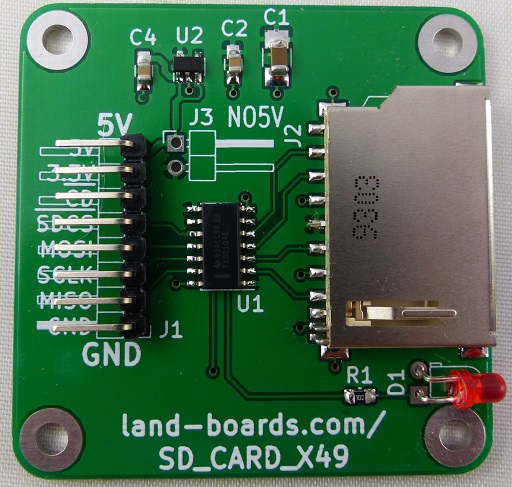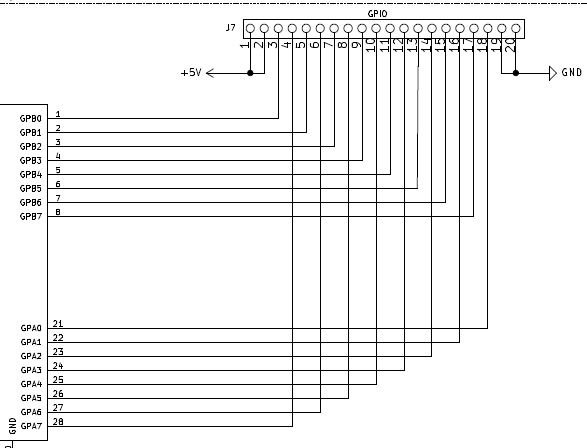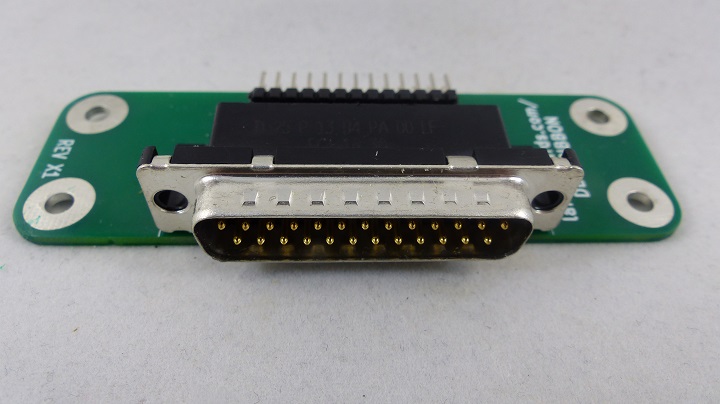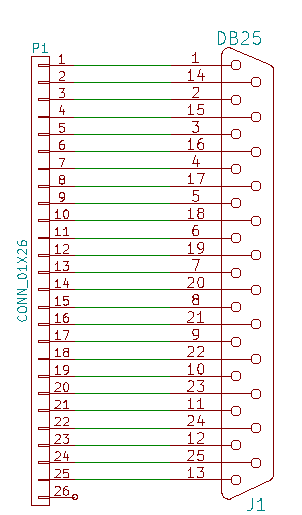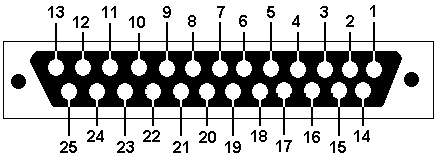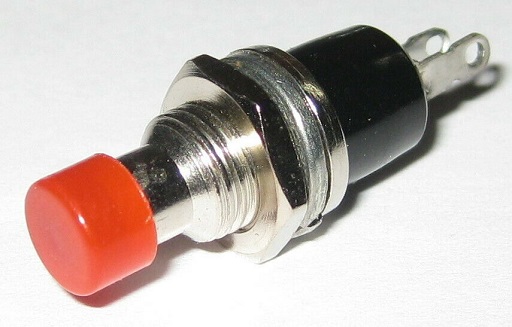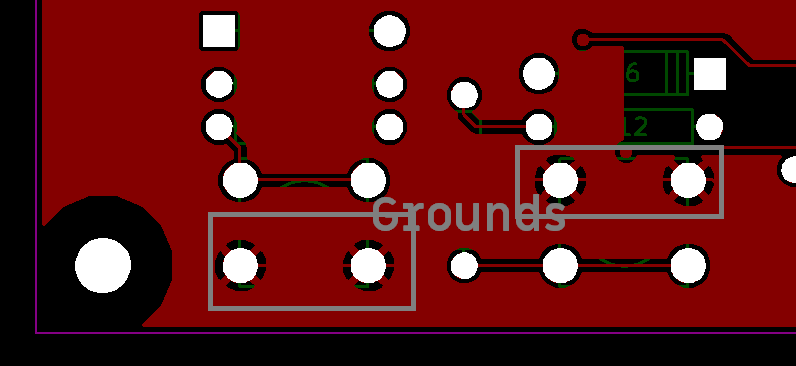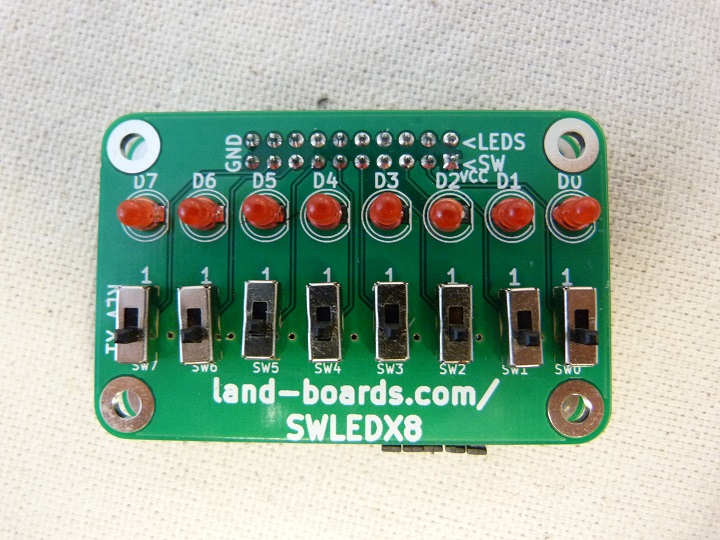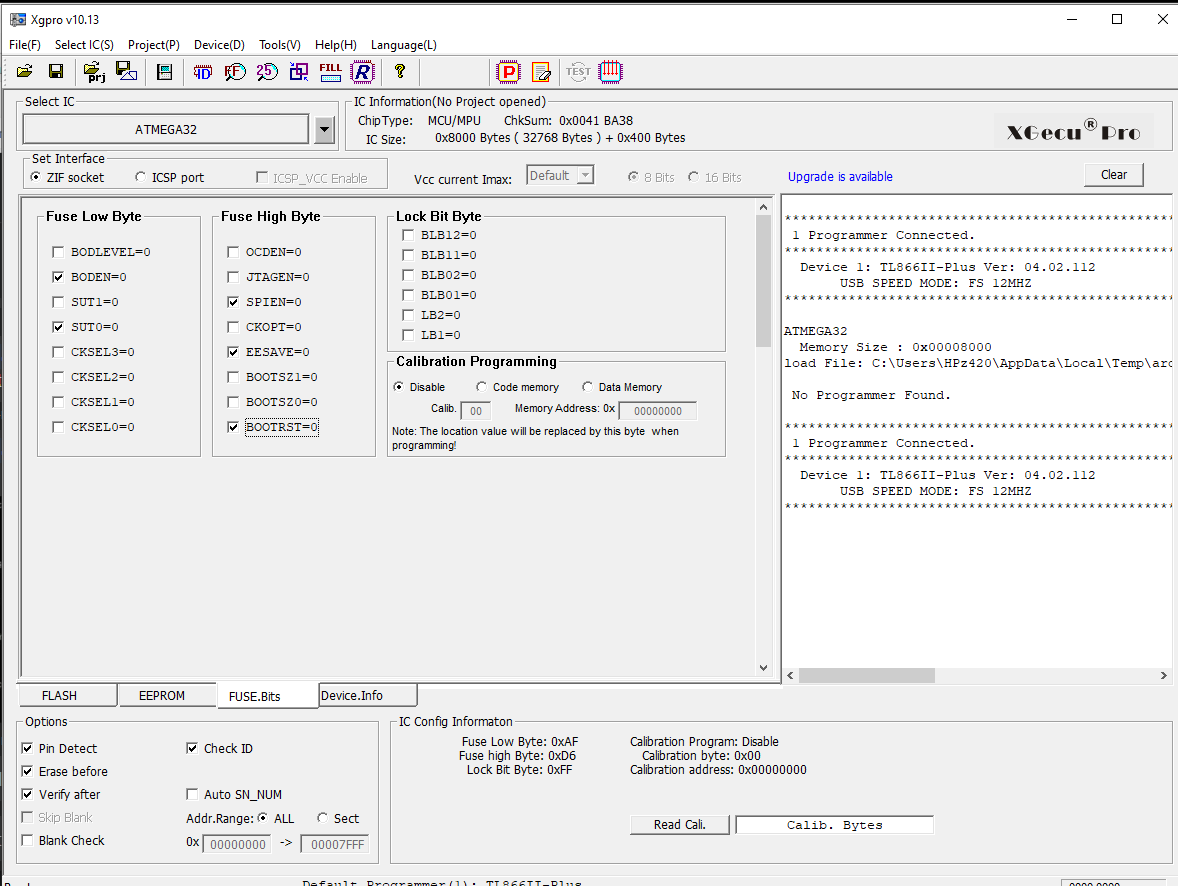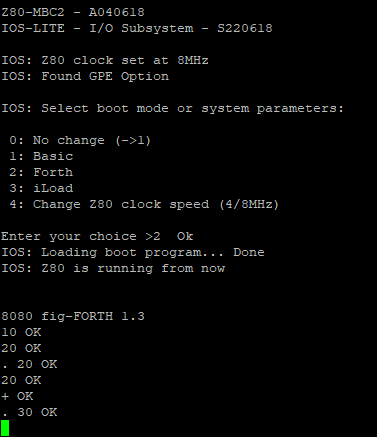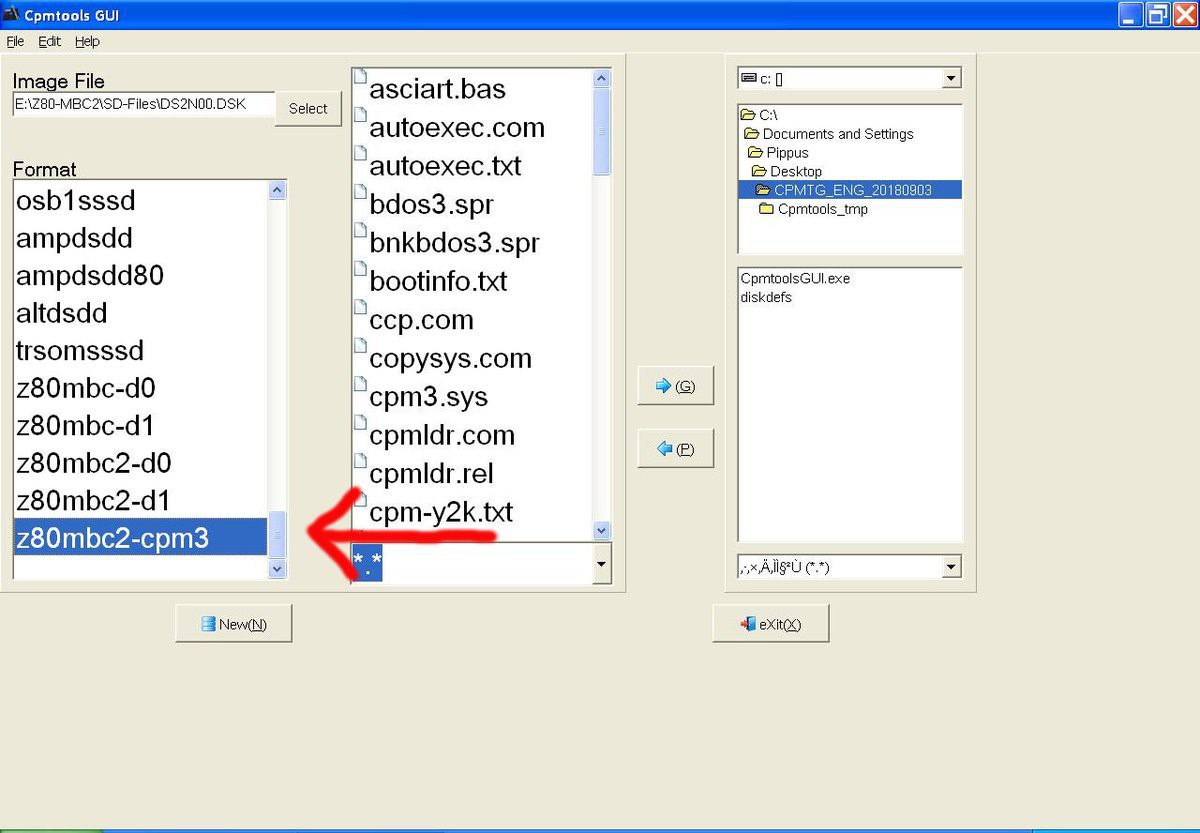Difference between revisions of "Z80-MBC2 Build Notes"
Jump to navigation
Jump to search
Blwikiadmin (talk | contribs) (→Parts) |
Blwikiadmin (talk | contribs) (→Parts) |
||
| Line 7: | Line 7: | ||
* [https://j4f.info/z80-mbc2 Z80-MBC2] card | * [https://j4f.info/z80-mbc2 Z80-MBC2] card | ||
** Z80 CPU CMOS (Z84C00) 8Mhz or greater - I used 20 MHz | ** Z80 CPU CMOS (Z84C00) 8Mhz or greater - I used 20 MHz | ||
| − | ** Atmega32A | + | ** [https://www.mouser.com/ProductDetail/Microchip-Technology-Atmel/ATMEGA32A-PU?qs=6WoM%2FY8vMbadJ8khIfKCsQ%3D%3D Atmega32A] |
** TC551001-70 (128kB RAM) | ** TC551001-70 (128kB RAM) | ||
** I used [https://www.mouser.com/ProductDetail/913-AS6C1008-55PIN AS6C1008-55PIN] since it is available on Mouser and Digikey | ** I used [https://www.mouser.com/ProductDetail/913-AS6C1008-55PIN AS6C1008-55PIN] since it is available on Mouser and Digikey | ||
** 74HC00 | ** 74HC00 | ||
| − | * I added the optional MCP23017 for GPIO | + | * I added the optional [https://www.mouser.com/ProductDetail/Microchip-Technology-Atmel/MCP23017-E-SP?qs=usxtMOJb1RyESXZDw7ia5A%3D%3D MCP23017] for GPIO |
* External cards | * External cards | ||
** External RTC | ** External RTC | ||
Revision as of 19:53, 5 September 2022
Contents
Parts
- Z80-MBC2 card
- Z80 CPU CMOS (Z84C00) 8Mhz or greater - I used 20 MHz
- Atmega32A
- TC551001-70 (128kB RAM)
- I used AS6C1008-55PIN since it is available on Mouser and Digikey
- 74HC00
- I added the optional MCP23017 for GPIO
- External cards
- External RTC
- External SD card
- Runs Petit FAT File System - Loads FAT32 SD cards loaded in Windows
- External USB-Serial adapter
- SWLEDX8 - LEDs card
- Custom wiring, no slide switches
- Bare Board on ebay - $8 shipping included
- Arrived in a couple of days
- Kit for sale
- Enclosure
Licensing and Credits
- All the project files (SW & HW) are licensed under GPL v3.
- If you use this material in any way a reference to the author (me :-) ) will be appreciated.
- CP/M seems to be Open Source now (see here).
- Basic stand-alone interpreter was an adaptation from Grant Searle work.
- Forth stand-alone interpreter was originally ported to the Z80-MBC by Bill Westfield.
- UCSD Pascal was ported by Michel Bernard.
- Collapse OS was designed and ported by Virgil Dupras.
Reference Docs
- An Easy to Build Real Homemade Computer: Z80-MBC2! - Instructable was helpful
- Hackaday project with files
- Our GitHub Repo
- Facebook page - Great group
Build Notes
- All through hole construction
- Build took less than 2 hours
- Used mostly junk box parts
- 20 MHz Z80 (Runs ar 4 or 8 MHz)
- Purchased alternate SRAM
- Purchased DIP machined sockets (I usually go cheaper but these were very nice)
- Forgot to buy SIP resistors
- Made my own SIP resistors
- Pin 1 (boxed pin on silkscreen is the common
- Used 1/8W resistors vertically mounted
- 5mm LEDs fit into 3mm hole spacing
- I didn't have a 3mm Blue so I used 5mm
- Ordered DS3231 AT24C32 IIC Precision Real Time Clock RTC Memory Module for Arduino
Negatives
- Ref des are not top-bottom or left-right
- Struggled to find some of the resistors on the PCB
- PDF Assembly drawing text is not searchable
- Serial port marking correlated to the FTDI card end not referenced from card internal
Enclosure
Card Set
- Z80-MBC2
- FTDI card
- SD card
- DB-25 to Ribbon cable card
- SWLEDX8 - LEDs mounted to front panel through this card (not shown in photo)
Front View
Top View
Rear View
Side/Top View
Connectors
- Triangle/arrow points to pin 1
J1 - I2C Expansion
J2 - Serial
- Connects to FTDI-49MM card
- Card does not have DTR line - used for serial download
- RTS-CTS not currently implemented in the IOS firmware
- Did wire to FTDI-49MM card in case it gets added in the future
J3 - ICSP
- Temporarily connected to ISP connector on ATProgHead for programming using Arduino as ISP connector and 2x3 jumper
- Used to power front panel LED (resistor on SWLEDX8 card)
- 2x3 to 1x2 Dupont cable
- Power (+5V) and ground pins (would be nice if silkscreen had +, - marked)
J4 - AUX PWR
- Unused/not installed in my build
J5 - RTC
- Pin 1 arrow nearest edge of PCB
- 4 pin Dupont cable (Pwr/Gnd/SDA/SCL)
- 2 of 6-pin (1x6) Dupont housting
- Uses pins 3-6 on both ends
- 2 of 6-pin (1x6) Dupont housting
- Wrap RTC in electrical tape to prevent accidental shorting
J6 - SD Card
- Connects to SD_CARD_X49 with 6, 8 pin connectors
- Clip out R20 to use LED on SD_CARD_X49
- SD_CARD_X49 set for 5V Host operation
J7 - GPIO
- Demo software in Disk Set 1, Drive A:, File: gpeled.bas
DB-25 connector
- Connect to DB25RIBBON card
- Use female DB-25 since power is exposed
- Wiring shown for male DB-25 connector
Z80-MBC2 to DB25RIBBON Card Wiring
| Port | J7 Pin | DB-25F Pin | P1 Pin | Color | Port | J7 Pin | DB-25F Pin | P1 Pin |
|---|---|---|---|---|---|---|---|---|
| GND | 20 | 1 | 25 | Black | GND | 19 | 14 | 24 |
| GPA0 | 18 | 2 | 23 | Brown | GPB0 | 3 | 15 | 22 |
| GPA1 | 16 | 3 | 21 | Orange | GPB1 | 5 | 16 | 20 |
| GPA2 | 14 | 4 | 19 | Yellow | GPB2 | 7 | 17 | 18 |
| GPA3 | 12 | 5 | 17 | Green | GPB3 | 9 | 18 | 16 |
| GPA4 | 10 | 6 | 15 | Blue | GPB4 | 11 | 19 | 14 |
| GPA5 | 8 | 7 | 13 | Violet | GPB5 | 13 | 20 | 12 |
| GPA6 | 6 | 8 | 11 | Grey | GPB6 | 15 | 21 | 10 |
| GPA7 | 4 | 9 | 9 | White | GPB7 | 17 | 22 | 8 |
| +5V | 2 | 10 | 7 | Red | +5V | 1 | 23 | 6 |
Switches
- Switching between IOS options requires access to Reset and User buttons
- Pushbutton switches for Reset and User added to Front Panel below SD card mounting
- Reset pushbutton switch is Blue (red would be better but my only red switch was Normally Closed switch)
- User pushbutton switch is Black
- Soldered wires directly to pushbutton switches on the Z80-MBC2 card
- Used Gerbers to find ground pins
- Chained grounds on switches
LEDs
- Diffused LEDs are better than clear LEDs
- Using 5mm LEDs
- SWLEDX8 - LEDs mounted to front panel through this card
- Removed LEDs from SBC-MBC2 and added 2 pin right angle headers
- Would have been easier if I had planned to have LEDs visible
- Higher resistor values would be better since the LEDs are pretty bright.
- D7 = Blue User LED
- D6 = Green IOS LED
- D5 = Red HALT LED
- D4 = White DMA LED
- D3 = White IOS LED
- D1 = Orange Power LED
- SD card LED is on the FTDI-49MM card
- Removed LEDs from SBC-MBC2 and added 2 pin right angle headers
- D2, D0 LED are not installed
- Resistor installed only for Power LED (Used 1K to reduce the brightness)
- Other LED resistors are on Z80-MBC2 card
- No Switches are installed on card
- Card is sawn off just below switch pins
- Wired to use LED and Switch pins on Header
- Header is mounted on the rear of the card
Programming THE ATMEGA32
- IOS-LITE build (no SD card support)
- Full build with SD card
- Was able to use ATProgHead ICSP 2x3 cable running Arduino as ISP to burn bootloader but not program the code
- Could not use any of my FTDI cards for serial programming since they have RTS/CTS but not DTR
- Most programmer setups in Arduino work just fine with RTS since both are usually pulled, but not the MightyCore
- This is speculation as to why but I am able to program Screwduino cards just fine
- Used TL866ii to program ATMEGA32 fuses
- The Fuse bits should be: High Byte 0xD6, Low Byte 0xAF, Lock Byte 0xCF.
- Reference: Setting AVR Fuse Bits
- If you use the programmer defaults it sets the clock to 1 MHz which gives a serial port rate of 600 baud (told me I needed to fix the fuses).
- Found path in dump in Arduino IDE:
Arduino: 1.8.13 (Windows 10), Board: "ATmega32, Yes (UART0), EEPROM retained, Standard pinout, BOD 2.7V, LTO disabled, External 16 MHz" Sketch uses 28642 bytes (88%) of program storage space. Maximum is 32256 bytes. Global variables use 1213 bytes (59%) of dynamic memory, leaving 835 bytes for local variables. Maximum is 2048 bytes. C:\Users\HPz420\AppData\Local\Arduino15\packages\arduino\tools\avrdude\6.3.0-arduino18/bin/avrdude -CC:\Users\HPz420\AppData\Local\Arduino15\packages\MightyCore\hardware\avr\2.1.3/avrdude.conf -v -patmega32 -carduino -PCOM23 -b115200 -D -Uflash:w:C:\Users\HPz420\AppData\Local\Temp\arduino_build_883457/S220618_IOS-LITE-Z80-MBC2.ino.hex:i
Software
IOS Lite
- IOS Lite does not include SD or RTC support but is useful in checkout
Boot ("Full" IOS)
- Includes SD support
Z80-MBC2 - A040618 IOS - I/O Subsystem - S220718-R240620 IOS: Z80 clock set at 8MHz IOS: Found GPE Option IOS: CP/M Autoexec is OFF IOS: Select boot mode or system parameters: 0: No change (3) 1: Basic 2: Forth 3: Load OS from Disk Set 0 (CP/M 2.2) 4: Autoboot 5: iLoad 6: Change Z80 clock speed (->4MHz) 7: Toggle CP/M Autoexec (->ON) 8: Change Disk Set 0 (CP/M 2.2) Enter your choice >3 Ok IOS: Current Disk Set 0 (CP/M 2.2) IOS: Loading boot program (CPM22.BIN)... Done IOS: Z80 is running from now Z80-MBC2 CP/M 2.2 BIOS - S030818-R140319 CP/M 2.2 Copyright 1979 (c) by Digital Research A>
SD Card (R240620)
- Disk Set 0 (CP/M 2.2)
- Disk Set 1 (QP/M 2.71)
- Disk Set 2 (CP/M 3.0)
- Disk Set 3 (UCSD Pascal)
- Disk Set 4 (Collapse OS)
Disk Set 0 (CP/M 2.2)
F>a:stat A: R/W, Space: 7908k - CP/M 2.2 B: R/W, Space: 8068k - Turbo Pascal Compiler v3.01A C: R/W, Space: 7664k - HI-TECH Z80 CP/M C compiler V3.09 D: R/W, Space: 8004k - Microsoft Fortran-80 Compiler v.3.44 E: R/W, Space: 7896k - Microsoft Basic-80 Compiler v.5.30a F: R/W, Space: 8176k G: R/W, Space: 8176k H: R/W, Space: 8176k I: R/W, Space: 8176k J: R/W, Space: 8176k K: R/W, Space: 8176k L: R/W, Space: 8176k M: R/W, Space: 8176k N: R/W, Space: 8176k O: R/W, Space: 8176k P: R/W, Space: 8176k Z80-MBC2 CP/M 2.2 BIOS - S030818-R140319 CP/M 2.2 Copyright 1979 (c) by Digital Research A>DIR A: ASCIART BAS : ASM COM : AUTOEXEC SUB : AUTOEXEC TXT A: D COM : DDT COM : DUMP COM : ED COM A: GENHEX COM : GPELED BAS : GPIO BAS : HELLO ASM A: HELLO COM : LOAD COM : MAC COM : MBASIC COM A: MBASIC85 COM : PEG COM : PIP COM : RTC BAS A: STARTREK BAS : STAT COM : SUBMIT COM : TREKINST BAS A: USERLED BAS : XMODEM CFG : XMODEM COM : XSUB COM A: ZDE16 COM : ZDENST16 COM B>DIR B: TINST COM : TURBO COM : ART TXT : TINST DTA B: TINST MSG : TURBO MSG : TURBO OVR : TURBOMSG OVR B: SA PAS : README TXT C>DIR C: $EXEC COM : ASSERT H : C COM : CGEN COM C: CONIO H : CPM H : CPP COM : CREF COM C: CRTCPM OBJ : CTYPE H : DEBUG COM : DEHUFF COM C: EXEC H : FLOAT H : HITECH H : LIBC LIB C: LIBF LIB : LIBR COM : LIMITS H : LINK COM C: MATH H : OBJTOHEX COM : OPTIM COM : OPTIONS C: P1 COM : README TXT : RRTCPM OBJ : SETJMP H C: SIGNAL H : STAT H : STDARG H : STDDEF H C: STDIO H : STDLIB H : STRING H : SYS H C: TIME H : UNIXIO H : ZAS COM D>dir D: CPMIO MAC : CRCKLIST CRC : CREF80 COM : DSKDRV MAC D: DTBF MAC : F80 COM : FCHAIN MAC : FORLIB REL D: INIT MAC : IOINIT MAC : L80 COM : LIB COM D: LPTDRV MAC : LUNTB MAC : M80 COM : TTYDRV MAC D: README TXT E>dir E: BASCOM COM : BASCOM HLP : BASCOM2 HLP : BASLIB REL E: BCLOAD : BRUN COM : CREF COM : CREF80 COM E: README TXT : L80 COM : LIB80 COM : M80 COM E: MBASIC COM : OBSLIB REL : RANTEST ASC : RANTEST BAS E: RANTEST COM : RANTEST REL : SAMPLE BAS : SAMPLE COM E: SAMPLE REL
Disk Set 1 (QP/M 2.71)
IOS: Current Disk Set 1 (QP/M 2.71) IOS: Loading boot program (QPMLDR.BIN)... Done IOS: Z80 is running from now Z80-MBC2 QP/M 2.71 Cold Loader - S160918 Loading... done Z80-MBC2 QP/M 2.71 BIOS - S150918 QP/M 2.71 Copyright 1985 (c) by MICROCode Consulting A>dir AUTOEXEC.QSB : D .COM : DHORIZ .COM : HELLO .QPM QBACKUP .COM : QINSTALL.COM : QPATCH .COM : QPIP .COM QPMCLK .MAC : QPMCMDS .TXT : QPMUTILS.TXT : QSTAMP .COM QSTAMPV .COM : QSTAMPX .COM : QSTAT .COM : QSUB .COM QSWEEP .COM : AUTOEXEC.TXT : TDCNFG .COM : ZDE16 .COM ZDENST16.COM : SYSGENQ .COM : ASCIART .BAS : ASM .COM DDT .COM : DUMP .COM : GENHEX .COM : GPELED .BAS GPIO .BAS : HELLO .ASM : HELLO .COM : LOAD .COM MAC .COM : MBASIC .COM : PEG .COM : RTC .BAS STARTREK.BAS : TREKINST.BAS : USERLED .BAS : MBASIC85.COM SETDATE .QSB A>b: B>dir TINST .COM : TURBO .COM : ART .TXT : TINST .DTA TINST .MSG : TURBO .MSG : TURBO .OVR : TURBOMSG.OVR SA .PAS : README .TXT : D .COM C>dir $EXEC .COM : ASSERT .H : C .COM : CGEN .COM CONIO .H : CPM .H : CPP .COM : CREF .COM CRTCPM .OBJ : CTYPE .H : DEBUG .COM : DEHUFF .COM EXEC .H : FLOAT .H : HITECH .H : LIBC .LIB LIBF .LIB : LIBR .COM : LIMITS .H : LINK .COM MATH .H : OBJTOHEX.COM : OPTIM .COM : OPTIONS . P1 .COM : README .TXT : RRTCPM .OBJ : SETJMP .H SIGNAL .H : STAT .H : STDARG .H : STDDEF .H STDIO .H : STDLIB .H : STRING .H : SYS .H TIME .H : UNIXIO .H : ZAS .COM : D .COM D>dir CPMIO .MAC : CRCKLIST.CRC : CREF80 .COM : DSKDRV .MAC DTBF .MAC : F80 .COM : FCHAIN .MAC : FORLIB .REL INIT .MAC : IOINIT .MAC : L80 .COM : LIB .COM LPTDRV .MAC : LUNTB .MAC : M80 .COM : TTYDRV .MAC README .TXT : D .COM E>dir BASCOM .COM : BASCOM .HLP : BASCOM2 .HLP : BASLIB .REL BCLOAD . : BRUN .COM : CREF .COM : CREF80 .COM README .TXT : L80 .COM : LIB80 .COM : M80 .COM MBASIC .COM : OBSLIB .REL : RANTEST .ASC : RANTEST .BAS RANTEST .COM : RANTEST .REL : SAMPLE .BAS : SAMPLE .COM SAMPLE .REL : D .COM
Disk Set 2 (CP/M 3.0)
>Disk Set 2 (CP/M 3.0) IOS: Current Disk Set 2 (CP/M 3.0) IOS: Loading boot program (CPMLDR.COM)... Done IOS: Z80 is running from now Z80-MBC2 CPMLDR BIOS - S180918 CP/M V3.0 Loader Copyright (C) 1982, Digital Research BNKBIOS3 SPR F600 0600 BNKBIOS3 SPR 5300 2D00 RESBDOS3 SPR F000 0600 BNKBDOS3 SPR 2500 2E00 60K TPA Z80-MBC2 128KB (Banked) CP/M V3.0 Z80-MBC2 BIOS Modules: S200918, S210918-R170319, S220918-R180319, S290918, S170319 A>dir A: ASCIART BAS : AUTOEXEC COM : AUTOEXEC TXT : BDOS3 SPR : BNKBDOS3 SPR A: CCP COM : COPYSYS COM : CPM3 SYS : CPM3-128 SYS : CPM3-64 SYS A: CPMLDR COM : CPMLDR REL : CPM-Y2K TXT : CRCK COM : DATE COM A: DEVICE COM : DIR COM : DUMP COM : ED COM : ERASE COM A: GENCOM COM : GENCPM COM : GENHEX COM : GET COM : GPELED BAS A: GPIO BAS : HELLO ASM : HELLO COM : HELP COM : HELP HLP A: HEXCOM COM : INITDIR COM : LIB COM : LINK COM : LOAD COM A: MAC COM : MBASIC COM : MBASIC85 COM : PATCH COM : PEG COM A: PIP COM : PROFILE SU : PUT COM : README 1ST : RENAME COM A: RESBDOS3 SPR : RMAC COM : RTC BAS : SAVE COM : SET COM A: SETDEF COM : SHOW COM : SID COM : STARTREK BAS : SUBMIT COM A: SYS128 SUB : SYS64 SUB : TREKINST BAS : TYPE COM : USERLED BAS A: XMODEM CFG : XMODEM COM : XREF COM : ZDE16 COM : ZDENST16 COM A: ZSID COM : CATCHUM COM : CATCHUM DAT : CATCONF COM : GORILLA COM A: LADCONF COM : LADDER COM : LADDER DAT B>dir B: ART TXT : SA PAS : TINST COM : TINST DTA : TINST MSG B: TURBO COM : TURBO MSG : TURBO OVR : TURBOMSG OVR : USERLED PAS C>dir C: $EXEC COM : ASSERT H : C COM : CGEN COM : CONIO H C: CPM H : CPP COM : CREF COM : CRTCPM OBJ : CTYPE H C: DEBUG COM : DEHUFF COM : EXEC H : FLOAT H : HITECH H C: LIBC LIB : LIBF LIB : LIBR COM : LIMITS H : LINK COM C: MATH H : OBJTOHEX COM : OPTIM COM : P1 COM : README TXT C: RRTCPM OBJ : SETJMP H : SIGNAL H : STAT H : STDARG H C: STDDEF H : STDIO H : STDLIB H : STRING H : SYS H C: TIME H : UNIXIO H : ZAS COM D>dir D: CPMIO MAC : CRCKLIST CRC : CREF80 COM : DSKDRV MAC : DTBF MAC D: F80 COM : FCHAIN MAC : FORLIB REL : INIT MAC : IOINIT MAC D: L80 COM : LIB COM : LPTDRV MAC : LUNTB MAC : M80 COM D: README TXT : TTYDRV MAC E>dir E: INSTALL COM : MAILMRGE OVR : MERGPRIN OVR : WIMSGS OVR : WS COM E: WS OVR : WSCHANGE COM : WSCHANGE OVR : WSCHHELP OVR : WSHELP OVR E: WSMSGS OVR : WSOVLY1 OVR : WSPRINT OVR : WSSHORT OVR : WSU COM
ADD FILES USING CPMTOOLSGUI
- The Z80-MBC2 maps any disk like A: B: C: etc. into an image file on SD card with this file name: DSxNyy.DSK;
- where x (from 0 to 9) is OS:
- 0 = CP/M 2.2
- 1 = QP/M 2.71
- 2 = CP/M 3
- and yy (from 00 to 15) is the disk (00 = A: 01 = B: etc.).
- where x (from 0 to 9) is OS:
- You can download CpmtoolsGUI (English Windows version) from here.
- Extract the file CpmtoolsGUI.exe in a new folder and add/overwrite the file diskdefs copying it from the folder cpmtools inside the SD.
STEP 1
- Select in the upper left window (Image File) of the CpmtoolsGUI tool the virtual disk where you want to add files.
- For CP/M 2.2 and QP/M 2.71: select "z80mbc2-d0" only for disk 0 or "z80mbc2-d1" for the others (disk 1 - 15) in the bottom left window (Format) of CpmtoolsGUI.
- In the following image is selected (Image File) the disk DS0N02.DSK that corresponds to the disk C: (yy = disk = 02) of the CP/M 2.2 OS (x = 0):
- In the center window you can see all the files inside the selected virtual disk (disk 0 - 15).
- Please note that if you choose an empty disk (like P:) you won't see any file name in the center window of the CpmtoolsGUI tool.
- In the following image is selected (Image File) the disk DS0N02.DSK that corresponds to the disk C: (yy = disk = 02) of the CP/M 2.2 OS (x = 0):
- For CP/M 3: select in the bottom left window (Format) of CpmtoolsGUI "z80mbc2-cpm3" for any disk.
- In the following image is selected (Image File) the disk DS2N00.DSK that corresponds to the disk A: (yy = disk = 00) of the CP/M 3 OS (x = 2):
- For CP/M 2.2 and QP/M 2.71: select "z80mbc2-d0" only for disk 0 or "z80mbc2-d1" for the others (disk 1 - 15) in the bottom left window (Format) of CpmtoolsGUI.
STEP 2
- To add one or more files to the selected virtual disk you have simply point the upper right selection window to the folder where the new files are stored in your PC, select them using the bottom right selection window and press the "<- P" button.
- After the add you'll see the added file names in the center window (together with the others file previously present).
STEP 3
- Exit from the the CpmtoolsGUI tool pressing the eXit button.
I/O Programming
- User Pushbutton
- User LED
- 16-bit GPIO
- GPIO is via MCP23017 - Datasheet
- Real-Time Clock
User LED and Pushbutton
userled.bas
01 REM **************************************** 02 REM 03 REM Z80-MBC2 USER led blink demo: 04 REM 05 REM Blink USER led until USER key is pressed 06 REM 07 REM **************************************** 08 REM 13 PRINT "Press USER key to exit" 14 LEDUSER = 0 : REM USER LED write Opcode (0x00) 15 KEYUSER = 128 : REM USER KEY read Opcode (0x80) 16 PRINT "Now blinking..." 18 OUT 1,LEDUSER : REM Write the USER LED write Opcode 20 OUT 0,1 : REM Turn USER LED on 30 GOSUB 505 : REM Delay sub 40 OUT 1,LEDUSER : REM Write the USER LED write Opcode 45 OUT 0,0 : REM Turn USER LED off 50 GOSUB 505 : REM Delay 60 GOTO 18 490 REM 500 REM * * * * * DELAY SUB 501 REM 505 FOR J=0 TO 150 506 OUT 1,KEYUSER : REM Write the USER KEY read Opcode 507 IF INP(0)=1 THEN GOTO 700 : REM Exit if USER key is pressed 510 NEXT J 520 RETURN 690 REM 691 REM * * * * * PROGRAM END 692 REM 700 OUT 1,LEDUSER : REM Write the USER LED write Opcode 710 OUT 0,0 : REM Turn USER LED off 720 PRINT "Terminated by USER Key"
GPIO
gpio.bas
1 REM * * * GPIO EXPANSION MODULE (A080117) DEMO * * * 2 REM 3 REM (USER Key -> slow led, GPIO-A(9) Key -> fast led) 4 REM -------------------------------------------------- 5 REM Demo HW wiring (see A080117 schematic): 6 REM 7 REM GPIO-B 8 REM (J3) 9 REM +----+ LED 10 REM | 2 |--->|---+ 11 REM | 3 |--->|---+ RESISTOR 12 REM | 4 |--->|---+ 680 13 REM | 5 |--->|---+-------/\/\/-----o GND 14 REM | 6 |--->|---+ 15 REM | 7 |--->|---+ 16 REM | 8 |--->|---+ 17 REM | 9 |--->|---+ 18 REM +----+ | 19 REM | 20 REM | 21 REM GPIO-A | 22 REM (J4) | 23 REM +----+ LED | 24 REM | 2 |--->|---+ 25 REM | 3 |--->|---+ 26 REM | 4 |x 27 REM | 5 |x 28 REM | 6 |x 29 REM | 7 |x PUSH BUTTON RESISTOR 30 REM | 8 |x --- 1K 31 REM | 9 |---------o o------------------/\/\/-----o GND 32 REM +----+ 33 REM 34 REM 35 REM 36 REM -------------------------------------------------- 37 REM 38 REM Set MCP23017 GPIOB all pins as output (IODIRB=0x00) 39 OUT 6, 0 40 REM Set MCP23017 GPIOA 0-1 as output, others as input (IODIRA=0xFC) 41 OUT 5, 252 42 REM Set MCP23017 GPIOA 2-7 pull-up resistor on (GPPUA=0xFC) 43 OUT 7, 252 45 REM Left Shift user funcion definition 50 DEF FNLSH(X)=((X*2) AND 255) 55 REM Init GPIO output ports 60 OUT 3, 0 : REM Clear MCP23017 GPIOA port 62 OUT 4, 0 : REM Clear MCP23017 GPIOB port 64 GOSUB 700 : REM Set slow shift 68 REM Main 70 A=1 80 FOR I=0 TO 7 90 OUT 4, A : REM Write to MCP23017 GPIOB port 100 GOSUB 500 110 A=FNLSH(A) 120 NEXT I 130 OUT 4, 0 : REM Clear MCP23017 GPIOB port 135 A=1 140 FOR I=0 TO 1 150 OUT 3, A : REM Write to MCP23017 GPIOA port 160 GOSUB 500 170 A=FNLSH(A) 190 NEXT I 200 OUT 3, 0 : REM Clear MCP23017 GPIOA port 210 GOTO 70 : REM Play it again, Sam... 220 REM 500 REM * * * * * DELAY SUB 505 FOR J=0 TO K 507 IF INP(0)=1 THEN GOSUB 700 : REM Read USER key 508 IF (INP(3) AND 128)=0 THEN GOSUB 600 : REM Read MCP23017 GPIOA 7 key 510 NEXT J 520 RETURN 530 REM 600 REM * * * * * SET FAST SHIFT SUB 610 K=1 620 OUT 0, 1 : REM USER led ON 630 RETURN 640 REM 700 REM * * * * * SET SLOW SHIFT SUB 710 K=30 720 OUT 0, 0 : REM USER led OFF 730 RETURN
Real-Time Clock
- Write 1 to Port 132
- Read 0 repeatedly
- SEC
- MINUTES
- HOURS
- DAY
- MONTH
- YEAR
- TEMP
rtc.bas
15 OUT 1,132 : REM Write the DATETIME read Opcode 20 SEC = INP(0) : REM Read a RTC parameter 30 MINUTES = INP(0) : REM Read a RTC parameter 40 HOURS = INP(0) : REM Read a RTC parameter 50 DAY = INP(0) : REM Read a RTC parameter 60 MNTH = INP(0) : REM Read a RTC parameter 70 YEAR = INP(0) : REM Read a RTC parameter 80 TEMP = INP(0) : REM Read a RTC parameter 83 IF TEMP < 128 THEN 90 : REM Two complement correction 85 TEMP = TEMP - 256 90 PRINT 100 PRINT "THE TIME IS: "; 110 PRINT HOURS; : PRINT ":"; : PRINT MINUTES; : PRINT ":"; : PRINT SEC 120 PRINT "THE DATE IS: "; 125 YEAR= YEAR+ 2000 130 PRINT DAY; : PRINT "/"; : PRINT MNTH; : PRINT "/"; : PRINT YEAR 135 PRINT "THE TEMPERATURE IS: "; 140 PRINT TEMP; : PRINT "C" 145 PRINT
Videos
